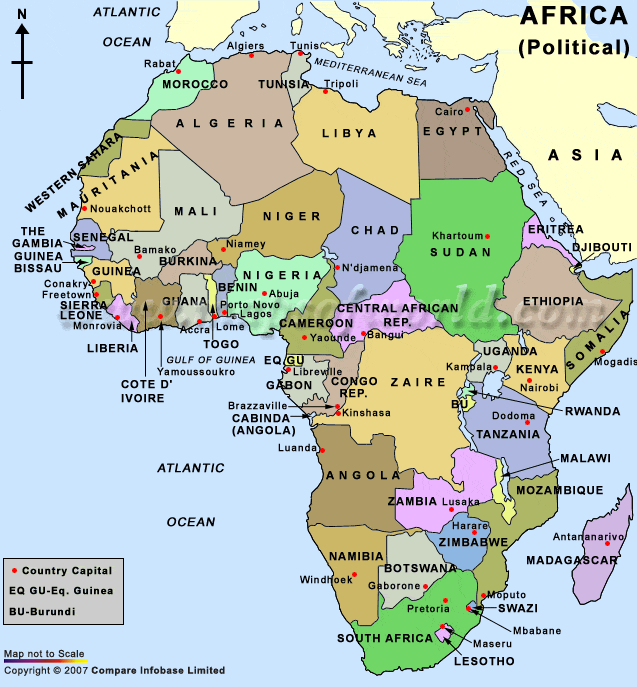
YEAR 9 REVISION -- HISTORY EXAMINATION
Remember that there are TWO sections
Section A will have TWO main questions on SLAVERY AND THE SLAVE TRADE.
Section B will have TWO main questions on WORLD WAR ONE.
You have to answer ONE question from Section A AND ONE question from Section B.
SECTION A
This section is on SLAVERY AND THE SLAVE TRADE.
There are TWO main questions -- Q1 and Q2
Each main question will have 4 sub-questions. So Q1 will have Q1a, Q1b, Q1c and Q1d and Q2 will also have 4 sub-questions.
To be able to answer the questions on slavery, you will need to know about the following:
(a) What life was like in Africa BEFORE the arrival of European slave traders -- focus on the Kingdom of Benin. What can wwe learn about the political, economic, social and cultural life in this kingdom? What does this tell us about life for black Africans? Was there slavery in Africa before the arrival of the European slave traders? Was this form of slavery different from the European system?
(b) The European involvement in the slave trade. Were the Europeans the first people from outside Africa who engaged in slavery? Why did the Europeans need black slaves? How were slaves acquired? How far were Africans themselves involved in the slave trade? How much profit could be made by European slave traders? What were slave forts? How were slaves treated?
(c) The Middle Passage. What was the Middle Passage? What was the Triangular Slave Trade? What were conditions like on board slave ships? How did the slaves react during the voyage?
(d) Slavery in the USA. What happened at slave auctions? How were slaves treated on the plantations? What happened to run away slaves?
TWO of the 4 topics above will be examined -- but you will not know which two until you open the exam paper. You will need knowledge to answer the questions, although the main focus will be on using sources.
To be able to answer the questions on The First World War, you will need to know about the following:
(a) Why war broke out in Europe. Why there was tension between countries. How the alliances formed. What triggered the war.
(b) Why people enlisted (voluntarily joined the army). What were the key reasons why so many men went willingly to war?
(c) Trench warfare. Why did trench warfare come about? What was life like in the trenches?
(d) The Battle of the Somme and War Poets. What happened at the battle of the Somme? Who were the war poets? How does their poems reflect the nature of the war?
Again TWO of the 4 topics above will be examined -- but you will not know which two until you open the exam paper. You will need knowledge to answer the questions, although the main focus will be on using sources.
TO HELP YOU, WE HAVE DETAILED NOTES ON ALL THE SECTION BELOW. MAKE SURE THAT YOU LOOK AT THESE AND USE THEM IF YOU HAVE NOTES MISSING FROM YOUR EXERCISE BOOKS. THESE NOTES CONTAIN ALL THE INFORMATION THAT YOU WILL NEED TO KNOW ON EVERY TOPIC.
NOTES
SLAVERY AND THE SLAVE TRADE
(a) LIFE IN AFRICA BEFORE THE ARRIVAL OF THE EUROPEAN SLAVE TRADES -- THE KINGDOM OF BENIN

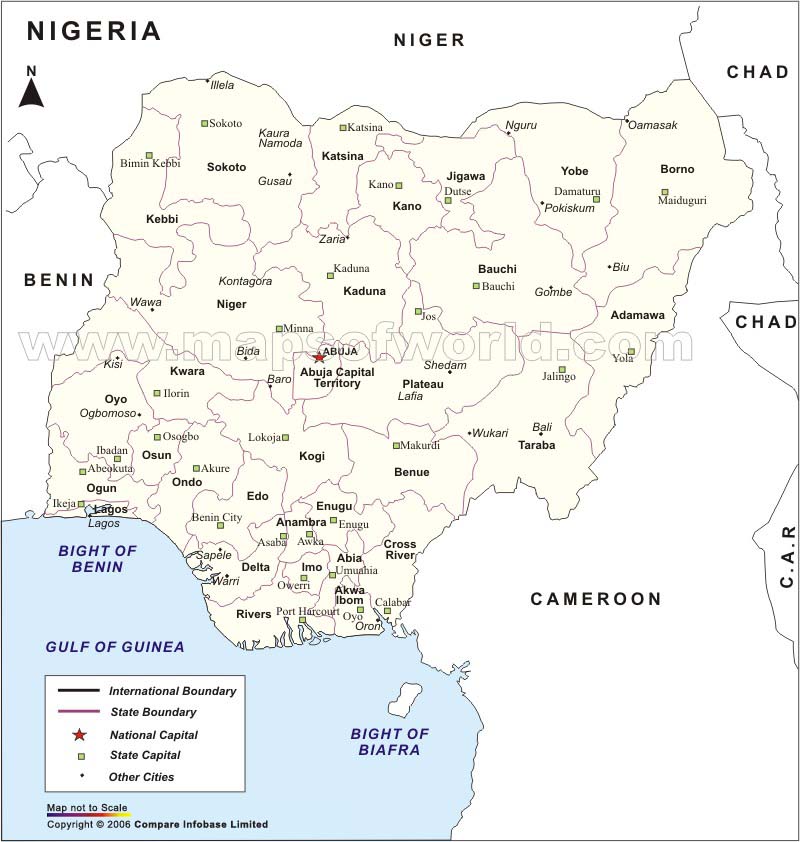
The Kingdom of Benin can be found in modern Nigeria. Find Benin City on the map above.
You will be expected to be able to talk about the following areas:
We can learn a lot from the account of Olaudah Equiano, who grew up in this area, before he was captured and taken into slavery. He wrote his autobiography in 1789 after gaining his freedom:
Equiano wrote his autobiography in 1789. In these extracts he described his early life in Africa.
That part of Africa, known by the name of Guinea, to which the trade for slaves is carried on, extends along the coast above 3400 miles, from Senegal to Angola, and includes a variety of kingdoms. Of these, the most considerable is the kingdom of Benin, both as to extent and wealth, the richness and cultivation of the soil, the power of the king and the number and warlike disposition of the inhabitants.
This kingdom is divided into many provinces or districts; in one of the most remote and fertile of which, called Eboe, I was born in the year 1745, in a charming fruitful vale named Essaka. The distance of the province from the capital of Benin and the sea coast must be very considerable; for I had never heard of white men or Europeans.
Our land is uncommonly rich and fruitful, and produces all kinds of vegetables in abundance. We have plenty of Indian corn, and vast quantities of cotton and tobacco. Our pineapples grow with culture; they are about the size of the largest sugar loaf, and finely flavoured. We have also spices of different kinds, particularly pepper; and a variety of delicious fruits which I have never seen in Europe; together with gum of various kinds and honey in abundance. All our industry is exerted to improve those blessings of nature. Agriculture is our chief employment; and everyone, even the children and women, are engaged in it. Thus we all habituated to labour from our earliest years.
Our tillage is exercised in a plain or common, some hours walk from our dwellings, and all the neighbours resort thither in a body. They use no beasts of husbandry; and their only instruments are hoes, axes, shovels and beaks, or pointed iron to dig with. Sometimes we are visited by locusts, which come in large clouds, so as to darken the air, and destroy our harvest. This however happens rarely, but when it does, a famine is produced by it.
As our manners are simple, our luxuries are few. The dress of both sexes is nearly the same. It generally consists of a long piece of calico, or Muslin, wrapped loosely around the body, somewhat in the form of a highland plaid. This is usually dyed blue, which is our favourite colour. It is extracted from a berry, and is brighter and richer than any I have seen in Europe. Besides this, our women of distinction wear golden ornaments, which they dispose with some profusion on their arms and legs. When our women are not employed with the men in tillage, their usual occupation is spinning and weaving cotton, which they afterwards dye and make into garments. They also manufacture earthen vessels, of which we have many kinds. Among the rest, tobacco pipes, made after the same fashion, and used in the same manner, as those in Turkey.
We are almost a nation of dancers, musicians and poets. Thus every great event, such as a triumphant return from battle, or other cause of public rejoicing, is celebrated in public dances which are accompanied with songs and music suited to the occasion. We have many musical instruments, particularly drums of different kinds, a piece of music which resembles a guitar, and another much like a stickado. These last are chiefly used by betrothed virgins, who play on them, all grand festivals.
Reading his account tells us a lot about life in Benin before the arrival of the European slave traders. Think what we can learn, e.g. they were mainly farmers, who had no machinery, but who produced crops such as pineapples. They had few luxuries .... and so on. Make sure that you know what life was like. Use this source to build up a picture.
The peoples of West Africa had a rich and varied history and culture long before European slavers arrived. They had a wide variety of political arrangements including kingdoms, city-states and other organisations, each with their own languages and culture.
The empire of Benin was large and powerful with a monarch heading complex political structures governing hundreds of thousands of subjects.
Art, learning and technology flourished and Africans were especially skilled in subjects like medicine, mathematics and astronomy. As well as domestic goods, they made fine luxury items in bronze, ivory, gold and terracotta for both local use and trade.
How does this match the stories told by European traders that Africans were primitive and ignorant people who were saved from a barbaric life by being taken into slavery?
Make sure that you can talk about the following areas:
(i)
Political (this is to do with how it was ruled)
(ii)
Economic (how wealthy it was)
(iii)
Culture and Society (what life was like, how society was organised, what
did they make, what items did they trade, did they have slaves, what sort of
education was available, what were their religious beliefs etc)
(iv) Military (did it fight wars and conquer other people?)
(i) Political -- ruled by a king. King was extremely powerful. So they had an effective form of government.
The King was ably assisted by a council composed of invited representatives from noble families, major artist guilds (groups), and professions. It was not a representative government, as people did not vote for someone to represent them. But the council members did represent the various people in the kingdom.
Kinship: Families stuck together and families helped other families. There was a unity in purpose and in culture that kept the kingdom together.
There was a strong army who job was to protect the people. There were laws that everyone followed - no one was above the law. Benin could go to war, and was forced to on occasion, but their warriors were fierce and capable; their leaders were wise; their people worked together as a team; and thus their normal state was a peaceful one.
(ii) Economic -- were rich and powerful. They traded with other kingdoms and grew crops that they sold. They lived simple lives but did not live in poverty.
Benin traded with other African kingdoms. Benin offered woven striped garments that were popular on the Gold Coast, blue fabric, pepper, jasper stones, and leopard skins. In exchange, Benin wanted red and silver fabrics - cotton, red velvet, embroidered silk, coarse flannel - candied oranges and lemons, mirrors, and iron bars. Jewellery was traded on both sides.
Benin traders were very shrew. They had a certain way of trading. If you didn't trade their way, they wouldn't trade. They might negotiate for days, or weeks, or even months before they would trade for goods. It was not easy to trade with Benin, but it was profitable. The artists of Benin were quite talented, and the demand for Benin striped fabrics, bronze statues, and carved masks was high.
The people of Benin did not tolerate mistreatment during trade or at any time, actually. If a foreign trader was rude, or if something was stolen, all trade came to an abrupt halt. The boycott would continue for all traders from all nations until restitution and/or apology was made and accepted.
(iii) Culture -- they produced sophisticated items (see below), they had a political system, they enslave their neighbours when they defeated them in war, but tended to treat their slaves as part of the family, they educated their children, they were muslims. The kingdom and the capital city were both called Benin. The city of Benin was laid out in a system of huge straight streets. These streets were very wide, very long, and well maintained although they were not paved. You could travel on foot in a straight line for 15 or 20 minutes and not see the end of the street. Other streets opened from the main streets. They were also wide. Houses were built in rows along all of the streets. On the street front side, houses had covered porches to keep people dry as they sat outside. They did not go to school in a building. Rather, in the evening, in the olden days of Benin, the village collected together to listen to the storytellers. Mothers and fathers taught kids at home. Those practicing a trade would accept children as students to teach them their trade. Children learned from the elders of the village who used proverbs to teach good behavior. There is a wonderful African proverb that states, "It takes a whole village to raise a child." There were many festivals. The people stopped working every month for several days to attend a festival. They believed work had to be balanced with play for a healthy life. They might be in the middle of a most important trade. Still, things came to a halt when it was festival time, no matter how important the trade.
(iv) They fought and defeated their neighbours. By taking over their neighbours territory, they became powerful.
Does all this suggest a primitive, barbaric people who would be better off as slaves?
Examples of Benin art
Yet it must also be remembered that slavery existed in Africa well before the arrival of the Europeans. Africans themselves enslaved one another, and Arab traders from the Middle East had captured slaves from Africa for hundreds of years before the arrival of the Europeans.
Slaves were obtained through conquest, tribute from vassal states (in the first such treaty, Nubia was required to provide hundreds of male and female slaves), offspring (children of slaves were also slaves, but since many slaves were castrated this was not as common as it had been in the Roman empire), and purchase. The latter method provided the majority of slaves, and at the borders of the Islamic Empire vast number of new slaves were castrated ready for sale (Islamic law did not allow mutilation of slaves, so it was done before they crossed the border). The majority of these slaves came from Europe and Africa -- there were always enterprising locals ready to kidnap or capture their fellow countrymen.
Black Africans were transported to the Islamic empire across the Sahara to Morocco and Tunisia from West Africa, from Chad to Libya, along the Nile from East Africa, and up the coast of East Africa to the Persian Gulf. This trade had been well entrenched for over 600 years before Europeans arrived, and had driven the rapid expansion of Islam across North Africa.
By the time of the Ottoman Empire, the majority of slaves were obtained by raiding in Africa. The great trade networks across north Africa were as much to do with the safe transportation of slaves as other goods. An analysis of prices at various slave markets shows that eunuchs fetched higher prices than other males, encouraging the castration of slaves before export.
Documentation suggests that slaves throughout Islamic world were mainly used for menial domestic and commercial purposes. Eunuchs were especially prized for bodyguards and confidential servants; women as concubines and menials. A Muslim slave owner was entitled by law to use slaves for sexual pleasure.
As primary source material becomes available to Western scholars, the bias towards urban slaves is being questioned. Records also show that thousands of slaves were used in gangs for agriculture and mining. Large landowners and rulers used thousands of such slaves, usually in dire conditions: "of the Saharan salt mines it is said that no slave lived there for more than five years."
So was slavery common in Africa before the arrival of the European slave traders?
(b) THE EUROPEAN INVOLVEMENT IN THE SLAVE TRADE
Why did Europeans become involved in the slave trade?
When Europeans discovered the New World (America), they needed labour to produce the crops, such as sugar, that were in huge demand in Europe. However, the natives were too weak and often died of diseases brought to the area by the Europeans. A large workforce was needed. Black Africans were much stronger and so they became the focus. They could be obtained cheaply and made to work hard. Millions were transported to the New World.
Quite often they could be obtained cheaply. Cheap manufactured goods were taken to Africa, such as cheap colourful beads. These cost virtually nothing to make. African chiefs were encouraged to believe that they were prized possessions. In exchange they traded people. The slavers got the slaves cheap and knew that they would earn a fortune for them in the New World. They could then use the money to buy sugar and cotton and transport these back to Europe where they could sell the goods for a fortune. The rewards of slavery were huge.
In Britain, many men and cities made a fortune out of slavery. Many of the fine buildings in cities like Bristol and Liverpool were built out of the profits from slavery. The house below was built by a slave trader from the profits he made from selling slaves
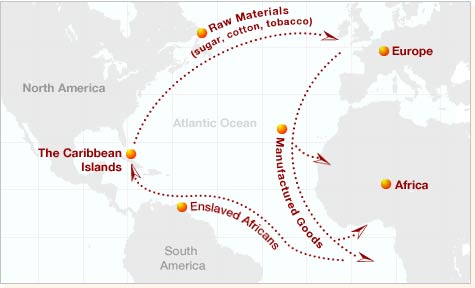
The map shows the Triangular trade. Cheap goods were sold to African chiefs in return for slaves. Slaves were then taken to America and goods taken to Europe.
(c) THE MIDDLE PASSAGE
Map showing how Black Africans were forcefully removed from Africa by slave trades and shipped to Europe, the Middle East and the Americas. The Middle Passage refers to the transportation of slaves from Africa to the Americas.
Once slaves were captured, they were taken to the coast and held in slave forts until the ships arrived to take them to America.
For weeks, months, sometimes as long as a year, they waited in the dungeons of the slave factories scattered along Africa's western coast. They had already made the long, difficult journey from Africa's interior -- but just barely. Out of the roughly 20 million who were taken from their homes and sold into slavery, half didn't complete the journey to the African coast, most of those dying along the way.
When I looked round the ship too and saw a large furnace of copper boiling, and a mulititude of black people of every description chained together, every one of their countenances expressing dejection and sorrow, I no longer doubted of my fate and quite overpowered with horrow and anguish, I fell motionless on the deck and fainted. . . . I asked if we were not to be eaten by those white men with horrible looks, red faces and long hair?"
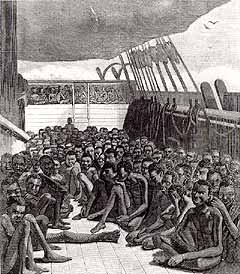 Published
in the June 2, 1860 issue of Harper's Weekly, The Slave Deck of the Bark
"Wildfire" illustrated how Africans travelled on the upper deck of
the ship. On board the ship were 510 captives, recently acquired from an area of
Africa near the Congo River. The author of the article reported seeing, upon
boarding the ship, "about four hundred and fifty native Africans, in a
state of entire nudity, in a sitting or squatting posture, the most of them
having their knees elevated so as to form a resting place for their heads and
arms."
Published
in the June 2, 1860 issue of Harper's Weekly, The Slave Deck of the Bark
"Wildfire" illustrated how Africans travelled on the upper deck of
the ship. On board the ship were 510 captives, recently acquired from an area of
Africa near the Congo River. The author of the article reported seeing, upon
boarding the ship, "about four hundred and fifty native Africans, in a
state of entire nudity, in a sitting or squatting posture, the most of them
having their knees elevated so as to form a resting place for their heads and
arms."
By slave ship standards, not many had died en route -- about 90 of the original
600. But the ship was not filled to capacity -- it could hold 1,000 slaves --
and the Africans were well-fed.
The Middle Passage was the most infamous route of this triangular trade. Although danger lurked constantly throughout the voyage across the Atlantic, the greatest danger to the slave ships always came when they were loading on the African coast. Once aboard the ships, the negroes realized that they were being sent far away from home, and often there was violence even before the ship set sail. However, most of these uprisings were easily put down. Others jumped overboard and plunged from the ship into the sea, choosing to either drown or be devoured by blood-thirsty sharks rather than be taken from their homeland.
 Once aboard the ships the blacks would
be packed below deck. Captains of slave ships were known as either "loose
packers" or "tight packers", depending upon how many slaves
they crammed into the space they had. Most ships, especially those of the
later 18th century, were "tight packers", carrying a huge quantity
of slaves who were often forced to lie in spaces smaller than that of a grave,
or in some cases stacked spoon-fashion on top of one another. Regardless, life
for a slave in the "tween decks", as they were called, was extremely
uncomfortable. In addition to extreme overcrowding, there was also inadequate
ventilation, not to mention little or no sanitation. Although some captains
would have their crew periodically clean the "tween decks" with hot
vinegar, most chose rather to leave them alone, resulting in their atrociously
unclean condition. In addition to disease and suffocation below deck, it would
not be uncommon to find the body of a slave completely covered by lice.
Once aboard the ships the blacks would
be packed below deck. Captains of slave ships were known as either "loose
packers" or "tight packers", depending upon how many slaves
they crammed into the space they had. Most ships, especially those of the
later 18th century, were "tight packers", carrying a huge quantity
of slaves who were often forced to lie in spaces smaller than that of a grave,
or in some cases stacked spoon-fashion on top of one another. Regardless, life
for a slave in the "tween decks", as they were called, was extremely
uncomfortable. In addition to extreme overcrowding, there was also inadequate
ventilation, not to mention little or no sanitation. Although some captains
would have their crew periodically clean the "tween decks" with hot
vinegar, most chose rather to leave them alone, resulting in their atrociously
unclean condition. In addition to disease and suffocation below deck, it would
not be uncommon to find the body of a slave completely covered by lice.
Eventually, after the arduous 3,700 mile voyage, the slave ship would reach North America. In order to strengthen them before sale, the slaves were normally fed better in the days directly before their arrival in the new world, however their suffering was far from over. Before they could be sold, the slaves would be oiled to make their skin shiny and any imperfections, such as scars from whippings, would be filled in with hot tar in order to improve their appearance and get the best market price. Most slave ships would not be allowed to dock in the ports which they came to due to their horrible stench and the fear of the spread of any diseases which had been spread throughout the ship. Therefore, the slavers would drop anchor a few miles off shore and carry the slaves to land in smaller boats which had been stored aboard the ship. The slaves would then be sold at auction and would live through the rest of their lives in wicked involuntary servitude.
During periods of good weather, the slaves would be brought up on deck in the morning. At this time the men would be shackled together with iron chains, while the women and children would be allowed to roam about on deck. At about nine o' clock in the morning they were given their first meal of the day. Interestingly, slaves from different sections along the west African coast would often be fed different meals. Those from the Northern part of the Guinea Coast would be fed boiled rice, millet, or cornmeal. Slaves from the Bight of Biafra had stewed yams, and those from still farther south in the Congo River region would be fed starchy manioc, cassava flour, or banana-like fruits. Sometimes a few lumps of raw meat would be thrown in with their food to keep them healthy. It was also at this time in the morning that the slaves were given their daily ration of a half-pint of water in a small pan, called a pannikin.In the late afternoon came the slaves' second and only other meal of the day. Sometimes it was the same as their first, but most captains were not that humane. The afternoon meal usually consisted only of horse beans, very large beans which are used to feed horses. They were the cheapest form of food available. The beans were boiled until they were pulpy and then covered with a mixture of palm oil, flour, and water. To cover up the horrible taste, large amounts of red pepper, called "slabber sauce", were added.
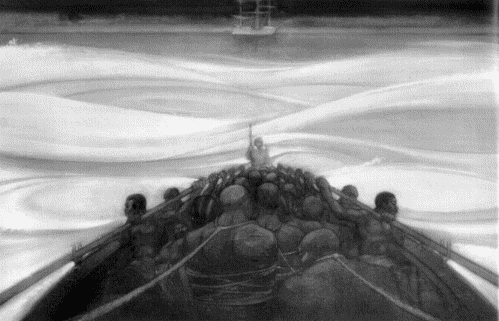 The
captains needed to keep the slaves in acceptable physical condition if they
were to be sold at high prices, so each morning after breakfast the slaves
were "danced" on deck, in order to give them exercise. Still
shackled together, the men were forced to jump up and down until often the
flesh of their ankles was raw and bleeding from the iron chains which bound
them together. The women and children, who were free of such bonds were better
able to dance to the rhythm that was pounded out on an African drum or iron
kettle, sometimes with the accompaniment of a fiddle or African banjo played
by a crew member. The slaves, otherwise kept miserably in the "tween
decks", enjoyed this dancing, as it was their only form of physical
recreation during the entire day. Each day at sunset the slaves would be
placed back below deck to rest in the misery and filth that was the "tween
decks".
The
captains needed to keep the slaves in acceptable physical condition if they
were to be sold at high prices, so each morning after breakfast the slaves
were "danced" on deck, in order to give them exercise. Still
shackled together, the men were forced to jump up and down until often the
flesh of their ankles was raw and bleeding from the iron chains which bound
them together. The women and children, who were free of such bonds were better
able to dance to the rhythm that was pounded out on an African drum or iron
kettle, sometimes with the accompaniment of a fiddle or African banjo played
by a crew member. The slaves, otherwise kept miserably in the "tween
decks", enjoyed this dancing, as it was their only form of physical
recreation during the entire day. Each day at sunset the slaves would be
placed back below deck to rest in the misery and filth that was the "tween
decks".
During the morning exercises members of the crew roved about the deck carrying whips and would beat those slaves who refused to "dance". Although most whips were made only of simple rope, the wicked cat-o'-nine-tails was also used aboard many slavers. Consisting of nine cords coated with tar, each with a knot at the end, the cat-o'-nine-tails could slash the skin of a slave's back to ribbons in only a few lashes.
Yet the worst time of the Middle Passage came for the slaves when the ship was met with periods of bad weather. During storms the blacks were forced to remain below deck all day and night. The holds were dark, filthy, slimy, and they stank of death. The "tween decks" were often full not only with slaves, both living and dead, but also with blood, vomit, urine, and human waste. Also during periods of inclement weather the slaves were not fed as usual. They were often forced to scrounge for small crumbs and pieces of spoiled food and drink from stagnant puddles of extremely impure water.
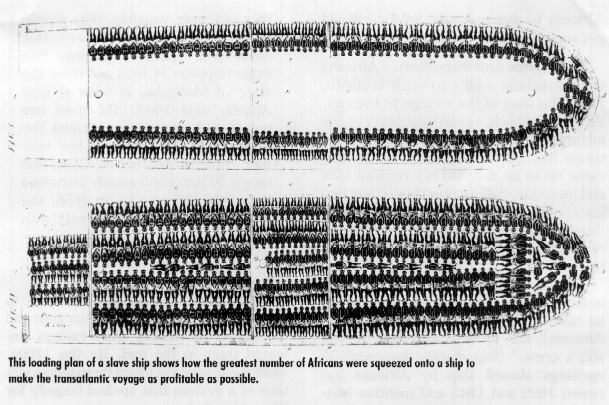
Another inhuman practice of the crews of the slave ships was that of "bedwarming". In this custom a member of the crew, or sometimes even the captain, would take a slave women out from the 'tween decks during the night. The woman would be taken back to either the captain's chamber or the crew's living quarters and be beaten and physically forced to have sexual relations with the crew member. This practice demonstrated the complete rape of the African-American culture by the slave traders of the Middle Passage, both figuratively and literally.
Some of the slaves who were transported along the Middle Passage attempted to rebel against the captain and crew. The negroes would make crude weapons out of their chains and shackles and attempt to kill crew members during the time when they were on deck. However, these uprisings were usually put down quickly by the crew, which used advanced weapons such as pistols and rifles to slaughter numerous slaves. Hence, although there were some successful slave mutinies along the Middle Passage, most Africans who attempted to revolt were killed in the process and thus put out of their misery.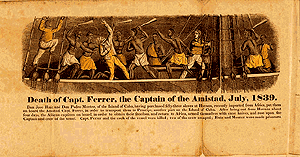 One of the few successful, and certainly
the most celebrated, slave revolts along the Middle Passage occured on the
Amistad. In this incident, A group of captive Africans, led by a Congolese
chief named Cinque, who were bound for Cuba rose up during their voyage across
the Atlantic in 1839. They were able to kill the captain and most of the crew,
completing a successful mutiny. They left a few crew members alive to sail
them back to Africa, but the remaining sailors tricked the Africans and landed
in the United States as well. A long legal battle ensued, as men even as
prominent as former President John Quincy Adams championed the Amistad blacks'
cause for freedom. Eventually the Supreme Court ruled that the Amistad
passengers were legally free and allowed them to return to Africa. These
events were dramatized in the recent Steven Spielberg movie "Amistad",
which has renewed tremendous popular interest in the history of the slave
trade.
One of the few successful, and certainly
the most celebrated, slave revolts along the Middle Passage occured on the
Amistad. In this incident, A group of captive Africans, led by a Congolese
chief named Cinque, who were bound for Cuba rose up during their voyage across
the Atlantic in 1839. They were able to kill the captain and most of the crew,
completing a successful mutiny. They left a few crew members alive to sail
them back to Africa, but the remaining sailors tricked the Africans and landed
in the United States as well. A long legal battle ensued, as men even as
prominent as former President John Quincy Adams championed the Amistad blacks'
cause for freedom. Eventually the Supreme Court ruled that the Amistad
passengers were legally free and allowed them to return to Africa. These
events were dramatized in the recent Steven Spielberg movie "Amistad",
which has renewed tremendous popular interest in the history of the slave
trade.
Many died along the voyage due to epidemics of disease, which spread like wildfire in the tightly packed 'tween decks. On board the slavers there were numerous outbreaks of the dreaded smallpox, as well as ophthalmia, a highly contagious disease which quickly resulted in complete blindness. These terrible ailments could rapidly afflict an entire cargo of slaves, as well as the crew, and wipe out entire ships in a matter of days.
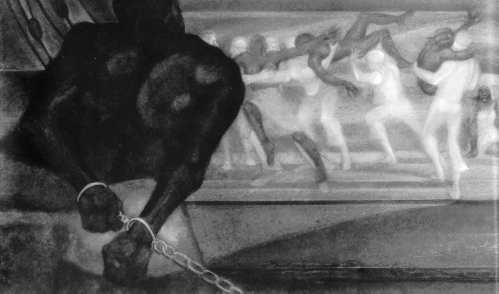 A few of the
Africans were driven insane by the claustrophobic misery they experienced
while on the ships. Those who had gone mad were often brought up on deck, at
which time they were either flogged or clubbed to death and then thrown
overboard. Those suffering from smallpox or ophthalmia were not quite so
fortunate. Anyone showing even the slightest sign of either of these diseases
was thrown overboard alive. This was done by the captain to prevent at all
costs an epidemic aboard the ship.
A few of the
Africans were driven insane by the claustrophobic misery they experienced
while on the ships. Those who had gone mad were often brought up on deck, at
which time they were either flogged or clubbed to death and then thrown
overboard. Those suffering from smallpox or ophthalmia were not quite so
fortunate. Anyone showing even the slightest sign of either of these diseases
was thrown overboard alive. This was done by the captain to prevent at all
costs an epidemic aboard the ship.
It is difficult for scholars to even estimate the number of Africans that died during the Middle Passage. Very few exact records were kept of those who expired during the voyage, but most historians feel reasonably confident in saying that nearly as many Africans died en route as made it to the Americas. From the records that do exist, it is telling that a voyage in which only one-quarter of the African captives died during the trip was considered a success. Although we will never know for sure how many unfortunate Africans met their deaths along the Middle Passage, it is certain that the death toll was staggering and that many of those taken from their homeland never even made it across the Atlantic. The millions of blacks that perished in the Middle Passage show the extreme callousness of those involved in the slave trade and the gross inhumanity with which the Africans were treated.
The Africans also frequently resorted to other acts of rebellion on the ships, including harming themselves, thus threatening the "cargo" of their captors. Many who had been taken from their homeland chose to take their own lives rather than to continue to suffer the unbearable conditions of the slave ship. Many jumped overboard when they had an opportunity. Others found ways to cut their throats. Some refused to eat and eventually starved to death. However, the slave captains, wanting to maintain as many of their slaves alive as possible, soon began employing methods to force feed the negroes. On some ships coal or fire would be placed near the lips of those who refused to eat. There were also captains who reportedly poured melted lead on slaves who were on hunger strikes. Another method used to force feed the Africans was a device called the speculum oris. The speculum oris was a wooden instrument, which looked much like a pair of dividers, and was forced into the slave's mouth. Then a thumb screw would be turned, causing the legs of the speculum oris to open like a pair of pliers. Once the black man's jaws were forced open food would be crammed down his mouth, often causing intense gagging and vomiting.
(d) SLAVERY IN THE USA
Once they arrived in America, they would be sold at auction.

Once in the Americas, slaves were sold, by auction, to the person that bid the most money for them. It was here that family members would find themselves split up, as a bidder may not want to buy the whole family, only the strongest, healthiest member.
Slave Auctions were advertised when it was known that a slave ship was due to arrive. Posters like the one pictured left would be displayed around the town.
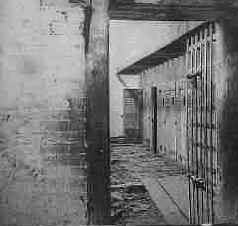
When the slave ship docked, the slaves would be taken off the ship and placed in a pen like this one. There they would be washed and their skin covered with grease, or sometimes tar, to make them look more healthy. This was done so that they would fetch as much money as possible. They would also be branded with a hot iron to identify them as slaves.
The slaves would be brought from the pen, in turn, to stand on a raised platform so that they could be seen by the buyers. Before the bidding began, those that wished to, could come up onto the platform to inspect the slaves closely. The slaves had to endure being poked, prodded and forced to open their mouths for the buyers.
The auctioneer would decide a price to start the bidding. This would be higher for fit, young slaves and lower for older, very young or sickly slaves. Potential buyers would then bid against each other. The person who bid the most would then own that slave. The picture below shows a slave being auctioned to the highest bidder.

All people who wanted to buy a slave on the day of the auction would pay the trader an agreed amount of money. The trader would then give them a ticket for each slave that they had bought. At the sound of a drum roll, the door to the slave pen would be opened and the buyers would rush in and grab the slave or slaves that they wanted. The buyers then checked their slaves out by returning their ticket or tickets to the slave trader.
The slave auction was a terrible ordeal for the slaves, they did not understand the language and had no idea what was happening.
Most slaves were required to work on the plantations producing cotton or sugar. Life was usually harsh and punishments brutal.
In the 17th
century Europeans began to establish settlements in the Americas. The division
of the land into smaller units under private ownership became known as the
plantation system. Starting in Virginia the system spread to the New England
colonies. Crops grown on these plantations such as tobacco, rice, sugar cane and
cotton were labour intensive. Slaves were in the fields from sunrise to sunset
and at harvest time they did an eighteen hour day. Women worked the same hours
as the men and pregnant women were expected to continue until their child was
born.
The death-rate amongst slaves was high. To replace their losses, plantation
owners encouraged the slaves to have children. Child-bearing started around the
age of thirteen, and by twenty the women slaves would be expected to have four
or five children. To encourage child-bearing some population owners promised
women slaves their freedom after they had produced fifteen children.
The
law provided slaves with virtually no protection from their masters. On large
plantations this power was delegated to overseers. These men were under
considerable pressure from the plantation owners to maximize profits. They did
this by bullying the slaves into increasing productivity.
The main method used to control the behaviour of slaves was the threat of having
them whipped. The number of lashes depended on the seriousness of the offence.
Austin Steward wrote that on his plantation 39 was the number for most offences.
Francis Fredric ran away and was free for nine weeks. After he was captured he
was given 107 lashes. Moses Roper, received 200 lashes and this was only brought
to an end when the master's wife pleaded for his life to be spared.
As they knew that as blacks were unable to give testimony against white people
in court, overseers knew that they were fairly safe in handing out these
whippings. In September, 1844, the St.
Louis Republican
reported that a eight year old black girl had been whipped to death. However,
the master of the girl was acquitted.
Women as well as men were whipped. This was one of the reasons why slaves
preferred to marry women from other plantations. Moses Grandy argued that:
"no colored man wishes to live at the house where his wife lives, for he
has to endure the continual misery of seeing her flogged and abused without
daring to say a word in her defence." Henry Bibb agreed pointing out:
"If my wife must be exposed to the insults and licentious passions of
wicked slave-drivers and overseers. Heaven forbid that I should be compelled to
witness the sight."
Resisting slavery
Not working hard enough
Talking too much or using their native language
Stealing from his master
Murdering a white man
Trying to run away
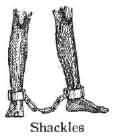
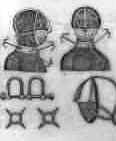

Being put in shackles
Being put in various contraptions
Being chained to the ground



Being whipped
Being forced to walk a treadmill
Being hung and left to die
The more serious the 'crime' committed, the more severe the punishment.
Plantation owners often made the other slaves watch the punishment to prevent them from slacking at work or trying to run away.
NOTES ON THE FIRST WORLD WAR
(a) WHY WAR BROKE OUT IN EUROPE
Firstly, you have to understand that by 1914 the major powers of Europe had divided into TWO military alliances. You will need to know what these alliances who, which country belonged to which alliance and why these alliances had emerged:
An alliance is an agreement made between two or more countries to give each other help if it is needed. When an alliance is signed, those countries become known as Allies.
A number of alliances had been signed by countries between the years 1879 and 1914. These were important because they meant that some countries had no option but to declare war if one of their allies. declared war first. (the table below reads clockwise from the top left picture)
| 1879 The Dual Alliance  Germany and Austria-Hungary made an alliance to protect themselves from Russia |
1881 Austro-Serbian Alliance  Austria-Hungary made an alliance with Serbia to stop Russia gaining control of Serbia |
1882 The Triple Alliance  Germany and Austria- Hungary made an alliance with Italy to stop Italy from taking sides with Russia |
| 1914 Triple Entente (no separate peace)  Britain, Russia and France agreed not to sign for peace separately. |
 |
1894 Franco-Russian Alliance  Russia formed an alliance with France to protect herself against Germany and Austria-Hungary |
| 1907 Triple Entente  This was made between Russia, France and Britain to counter the increasing threat from Germany. |
1907 Anglo-Russian Entente  This was an agreement between Britain and Russia |
1904 Entente Cordiale  This was an agreement, but not a formal alliance, between France and Britain. |
One of the main reasons why Britain and German came to mistrust one another was the issue of Imperialism.
Imperialism is when a country takes over new lands or countries and makes them subject to their rule. By 1900 the British Empire extended over five continents and France had control of large areas of Africa. With the rise of industrialism countries needed new markets. The amount of lands 'owned' by Britain and France increased the rivalry with Germany who had entered the scramble to acquire colonies late and only had small areas of Africa. Note the contrast in the map below. The Germans wanted to expand their empire, but this would mean conflict with Britain and France.
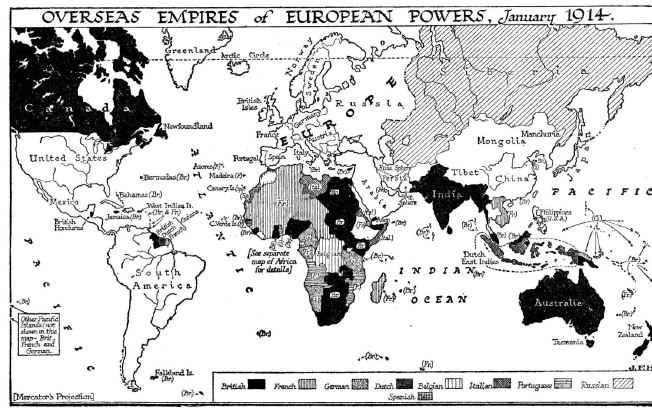
Another area of dispute between Britain and Germany was the issue of militarism.
Militarism means that the army and military forces are given a high profile by the government. The growing European divide had led to an arms race between the main countries. This means that everyone is spending vast sums of money on military equipment. The armies of both France and Germany had more than doubled between 1870 and 1914 and there was fierce competition between Britain and Germany for mastery of the seas. The British had introduced the 'Dreadnought', an effective battleship, in 1906. The Germans soon followed suit introducing their own battleships. The German, Von Schlieffen also drew up a plan of action that involved attacking France through Belgium if Russia made an attack on Germany. The map below shows how the plan was to work.
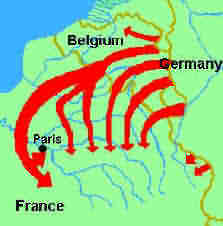
Another area of dispute was over nationalism.
Nationalism means being a strong supporter of the rights and interests of one's country. After the defeat of Napoleon in 1815 the victorious countries met and agreed on a new Europe. They ignored the wishes of the German and Italian people to live in united countries and left these countries divided into separate states. this annoyed many Germans and Italians who wanted to live in a united country. Strong nationalist elements led to the re-unification of Italy in 1861 and Germany in 1871. These countries now wanted to be powerful and were looking to expand their power and influence, but this would mean someone else would lose power. The Germans had attacked France in 1870 (The Franco-Prussian War) and had seized French territory (Alsace-Lorraine). The settlement at the end of the Franco-Prussian war left France angry at the loss of Alsace-Lorraine to Germany and keen to regain their lost territory. In addition in 1914 there were huge empires dominating Europe and the world. Austria had a huge empire in south-east Europe (the area known as the Balkans). Its empire was known as Austro-Hungary and included lots of different races, many of whom hated being controlled by Austria and wanted their own independent countries.
There are a number of useful links where you can download sheets telling you about how the war began:
http://www.schoolhistory.co.uk/year9links/wwi/explosivewwi.pdf
http://www.schoolhistory.co.uk/gcselinks/wars/firstwwlinks/worksheets/alliances_map.pdf
http://www.schoolhistory.co.uk/gcselinks/wars/firstwwlinks/worksheets/alliances_map.pdf
http://www.schoolhistory.co.uk/year9links/wwi/Causesofwar.PDF
You need to know why the alliances emerged and who was a member of which alliance and why.
(b) WHY MEN WENT TO WAR
There are a number of reasons why people went to war. You will be expected to know a range of reasons. When war broke out in 1914 millions of men volunteered. By 1916 there was a shortage and men were forced to join, in what was known as conscription. But why did so many men volunteer in 1914-16?
(1) Anger against a brutal enemy
When war broke out, German tried to attack France through Belgium. Britain had promised to protect Belgium and so declared war on Germany. All kinds of stories were used to ensure people were angry against Germany and to volunteer to fight against the German monsters.
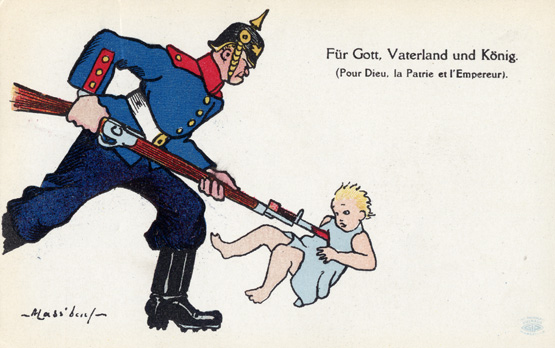
This picture showing a German soldier bayoneting a baby was just one example of the sort of material used by English newspapers to convince men that the Germans were evil and that every man had a duty to join the army and stop the Germans.
(2) False impression of what the war was like
Men had been taught at school that war was glorious. they were told stories about courageous soldiers fighting against wicked enemies. The poster below shows how men were led to believe that it would all be great fun. Nothing of the reality of trench warfare was shown.
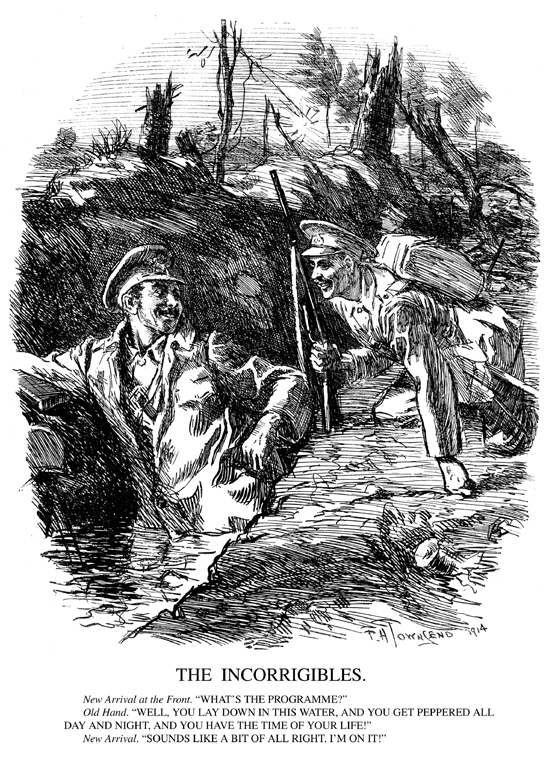
(3) The use of posters to pressurise men to join
Everywhere men went there were posters trying to persuade them to join, such as the one below
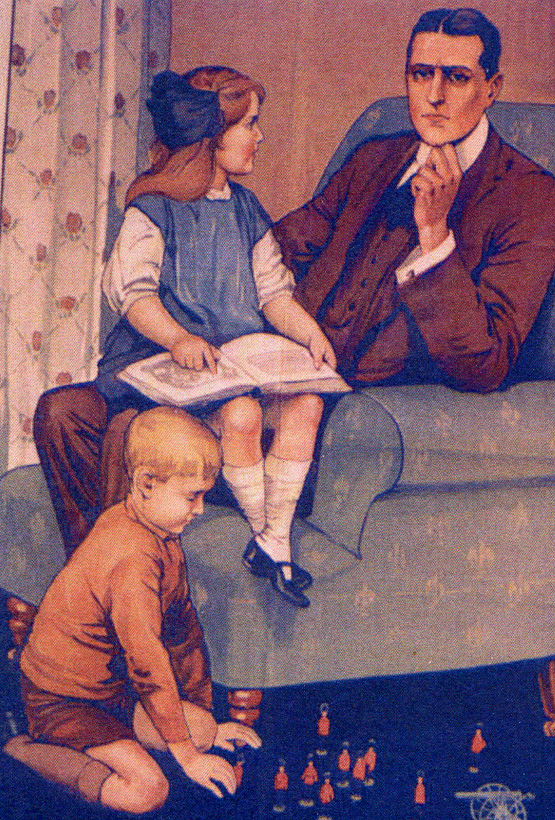
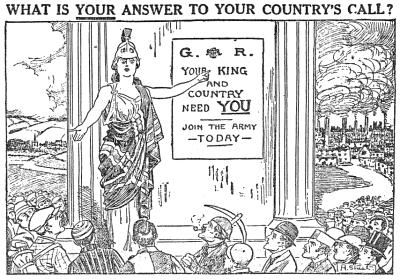 |
Left: From the Accrington Observer & Times of 15th September 1914. The caption read: "The day" has come for you, young man - the great day of decision! Will you fight for your King and Country, or will you skulk in the safety your fathers won and your brothers are struggling to maintain. England awaits your answer at the nearest recruiting office. GO! |
(4) Pressure from women
Women were used to try to pressurise men to join. Posters were produced urging women to put pressure on their husbands, boyfriends and sons to enlist
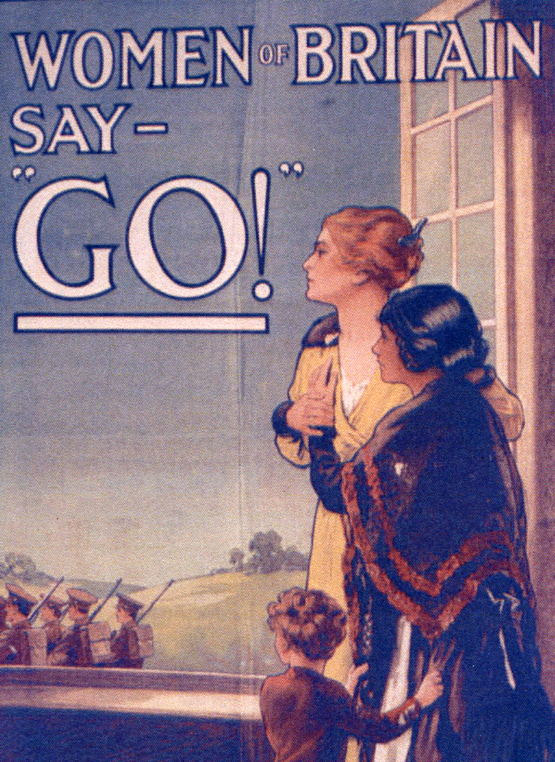
A group called the Women's Active Service league was set up. Women who joined pledged to never be seen with a man unless he was in uniform. Women would also hand out white feathers to men who were not in uniform -- implying that they were cowards.
(5) Joining with friends
Some people joined because their lives were boring and their friends had joined. The army tried to encourage groups of friends to join by setting up pal's Battalions.
(6) Patriotism
Many men felt it was their duty to fight and, if need be, to die for their country.
(c) TRENCH WARFARE
People went to war in 1914 believing it would be a quick war. Instead it lasted 4 years and millions died in the trenches on the Western Front.
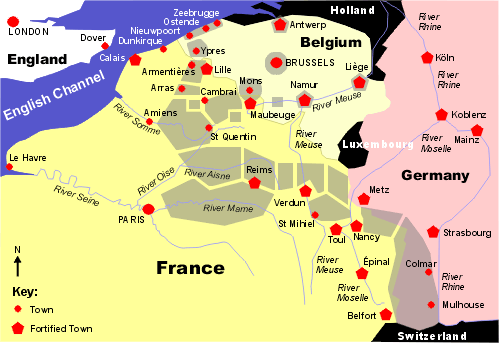
This map shows the Western Front. It is the line of trenches along the border of France and Belgium where most of the fighting between the Germans and the Allies occurred.
The First World War was the first major conflict that made use of what we would consider to be 'modern' weapons. No longer were the Cavalry and the sword the most potent weapons on the battlefield. It was now a case of the machine gun and a gas canister taking control of the battle.
Trenches came about as a result of the German General Erich von Falkenhayn ordered his men to dig in to stop the Allies from advancing any further. Unable to break through this line of German defences the British and French had little option but to defend themselves by digging trenches themselves: otherwise the Germans would have been able to counter attack with ease.
Trenches were not nice places to live and fight in. They were often waterlogged, and had little if any comforts such as heating and toilets. Much of the time the trenches were as little as 40 metres away from the enemy and the method of attack was to 'go over the top' of the trench and charge at the opposing trench. Millions died as machine guns cut through most soldiers well before they reached the trenches.

You will need to know what life was like in the trenches. you will need to know about the following:
the trench system
Barbed wire
No Man's Land
Shell-Shock
Trench Foot
Rations
Snipers
Over the Top
Poisonous gas
You should look at the following sites to find out what life in a trench was like:
http://www.firstworldwar.com/features/trenchlife.htm
http://www.spartacus.schoolnet.co.uk/FWWtrenchsystem.htm
http://www.1914-1918.net/intrenches.htm
http://www.spartacus.schoolnet.co.uk/FWWtrench.htm
(d) THE SOMME AND WAR POETS
The Somme was the greatest military disaster for the British army. You need to know what happened and why it was a disaster
This account will give you all the answers:
http://www.spartacus.schoolnet.co.uk/FWWsomme.htm
You will also be expected to be able to write about ONE poet and ONE of his poems. You will need to explain what his poem shows and why he became disillusioned by the war. Look at Wilfred Owen or Siegfried Sassoon.
Click on links below
good luck!!